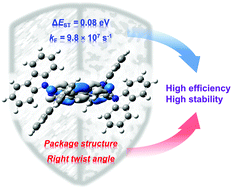Efficient and stable deep blue thermally activated delayed fluorescent molecules based on a bipyridine acceptor core†
Abstract
High efficiency and low cost organic light-emitting diodes (OLEDs) employing thermally activated delayed fluorescent (TADF) materials have attracted great attention. However, combining high quantum efficiency and stability is still challenging for deep blue TADF OLEDs. Here, we report a type of novel blue TADF emitter consisting of a bipyridine weak acceptor and four carbazole donors. These D–A-type emitters exhibit a high fluorescence rate of 9.8 × 107 s−1 and a small ΔEST of 0.08 eV owing to the energy approach of the frontier orbitals on the isolated D/A segments and adequate overlap of the frontier orbitals in the D–A systems. The organic light-emitting diodes containing these emitters offer deep blue emission with a half-width of 58 nm. High external quantum efficiencies of 15.3% and 18.7% are achieved in devices with emission maxima at 459 nm and 471 nm, respectively. In comparison to the structurally analogous TADF emitters with a π-bridge between the donor and acceptor moieties, the bipyridine/carbazole derivatives with a compact “donors-surrounding-acceptor” structure exhibit superior stability in both photoluminescence and electroluminescence.



 Please wait while we load your content...
Please wait while we load your content...